I think this guy is saying… “OK. God will handle cleaning and maintenance, you just shout ‘God is Great!' and start firing.”
And the rest, they say, is history…
I think this guy is saying… “OK. God will handle cleaning and maintenance, you just shout ‘God is Great!' and start firing.”
And the rest, they say, is history…
This is very cool… Fight like a girl…
ALL NEW SAFARILAND TRAINING FOR FEMALE OFFICERS
JACKSONVILLE, Florida –Safariland™, a BAE Systems line of business,announces the debut of the latest offering from the Safariland Training Group,the Female Officer Survival Training Tactics course, which is availableimmediately.
This four-day course, developed by female law enforcement officers, provides female officers the skills to confidently engage and thwart lethalthreatening situations. Highlightsof the course include improved firearms accuracy, advanced gun fighting skills, defensive tactics specific to the female officer,and improving tactical decision-making skills throughscenario-based training.
This program provides an opportunity for female officers to train in a comfortable learning environment at the range, in the gym and in theclassroom. The course will provideeach student with a personalized assessment of her particular skill sets andidentify any areas to focus for development.
“Female officers put their lives on the line every day, just like male police officers, yet theyhave to overcome some inherent challenges,” said Sandy Wall, Safariland’sDirector of Training. “Ourtalented Safariland Training Group female instructors have experienced thesechallenges first hand in their careers and have built this course to offertheir fellow officers options and tactics to help survive the street.”
Safariland Training Group’s chief instructor for the course is Dorcia Meador, a 31-year veteran of the Fort Worth Police Department, who isconsidered by many as one of the best female shooters in the country. She is a four-time women’s NRA champion and holds numerous nationalrecords in police pistol combat competitions, 1500 PPC revolver, and PolicePistol Combat semi-auto. Joining Meador is Lt. Amy Forster of the Vancouver Police Department,who is a recognized expert in ground and hand-to-hand fighting, and BelindaSelvey of the Fort Worth PD, who is an accomplished tactical instructor.
https://www.safariland.com/training/Patrol-Related/OfficerSurvivalforFemales.aspx
For information on registration, as well as a complete listing of classes andschedules, visit www.safariland.com/training.
Two suspects are in custody after they tried to rob a retired SBPD officer at gunpoint Wednesday night in South Bend. The retired officer shot at least one of them during the altercation.
 Two suspects are in custody after the attempted armed robbery of a retired SBPD officer on Thursday night in South Bend.
Two suspects are in custody after the attempted armed robbery of a retired SBPD officer on Thursday night in South Bend.
It happened just before 8:00 p.m. in the 1000-block of Woodbine Way, south of the airport.
Police say two brothers,18-year-old Presley Brown and 22-year-old Prescott Brown, approached retired Lt. John Collins, a former SBPD officer of 27 years, as he got out of his car after returning home from his current job. Presley Brown allegedly pointed a sawed-off shotgun at Collins and tried to rob him, but an altercation ensued.
Collins then shot at least one of the suspects. One of them jumped into a waiting getaway car and drove to Memorial Hospital where they were both arrested. Presley Brown was the one shot by Collins. He was shot in the arm and foot. Those injuries were non-life threatening.
The other suspect was in the car and after arriving in the parking garage at Memorial Hospital, he fled. It is not known if he was also shot.
Collins was not injured. Read more
Source: wndu.com
Recommended Concealed Carry Resources:
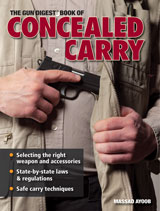 The Gun Digest Book of Concealed Carry
The Gun Digest Book of Concealed Carry
The Gun Digest Book of Combat Handgunnery
Effective Handgun Defense, A Comprehensive Guide to Concealed Carry
Find more resources at gundigeststore.com/tactical
Designation as USMC FROG (Flame Resistant Organizational Gear) Glove Leads To Order for 90,000 Pairs
 The Wiley X Raptor Combat Glove (Model #U501) has been designated as a USMC FROG (Flame Resistant Organizational Gear) Glove, leading to a substantial order from the United States Marine Corps.
The Wiley X Raptor Combat Glove (Model #U501) has been designated as a USMC FROG (Flame Resistant Organizational Gear) Glove, leading to a substantial order from the United States Marine Corps.
Based on a 12-month agreement that began in October 2011, Wiley X will be providing 90,000 pairs of its state-of-the-art Raptor Combat Gloves to protect the hands of Marines in action around the world.
“As a veteran owned company, we’re proud of this selection and pleased that Wiley X will be protecting the hands of U.S. Marines — as they protect freedom and liberty around the globe,” said Wiley X Co-Owner Myles Freeman, Jr. “U.S. Marines are well known as the best trained, best equipped fighting force on the planet, and we are pleased to be playing a small role in their safety,” added Freeman. In addition to providing American marines with Mil-Spec hand protection, Wiley X is a leader in ballistic protective eyewear systems for military and law enforcement use.
The Wiley X Raptor Combat Glove is engineered to provide maximum hand protection without sacrificing operational performance. With its Mil-Spec Nomex top and sleeve for both thermal and abrasion protection as well as its goatskin leather, the Wiley X Raptor Combat Glove meets the United States Marine Corps FROG requirements.
The Wiley X Raptor Combat Glove is also constructed to help marines perform at their best, with digital print goatskin leather for increased grip and tactile dexterity. Ergonomically shaped goatskin leather patches on the palm and leather reinforcement on the thumb strengthen high wear areas and increase overall durability.
Wiley X offers the Raptor Combat Glove in Small, Medium, Large, X-Large and XX-Large, providing the ideal size match for a wide range of fighting men and women. In addition, a cuff closure on the forearm provides a custom fit for all wearers. The Wiley X Raptor Combat Glove is custom designed to match a variety of U.S. military uniforms.
The glove will be available to consumers starting in 2012.
The Wiley X Raptor Combat Glove is available through GSA. To learn more about this and other protective products for tactical situations, contact Wiley X, Inc. at 7800 Patterson Pass Road, Livermore, CA 94550 • Telephone: (800) 776-7842 • Or visit online at www.wileyx.com.
Resources for Tactical Operators
The Gun Digest Book of Tactical Gear
The Gun Digest Book of Tactical Weapons Assembly/Disassembly
Own the Night: Selection and Use of Tactical Lights and Lasers
Tactical Pistol Shooting: Your Guide to Tactics that Work, 2nd Ed.
Made from durable, glass-filled nylon, these rugged, smooth-feeding magazines are available in ten-round, five-round, and three-round capacities.
“Consumers have made many requests for lower cost Ruger Gunsite Scout Rifle magazines,” said Mark Gurney, Ruger's Long Gun Product Manager. “These new Ruger magazines are durable, easy to load, feed smoothly, and are less than half the price of original equipment steel magazines. The three-round magazine is near flush-fitting and is a great accessory to have when hunting with the Ruger Gunsite Scout Rifle rifle,” he concluded.
Ruger Gunsite Scout Rifle polymer magazines can be readily disassembled and assembled for cleaning. All components are molded from glass-filled nylon (except the stainless steel spring), and the assembled magazines have been function and drop tested at extreme temperatures ranging from -30° F to +140° F. A snap-on dust cover, which not only keeps the internals of the magazine clean, but also allows long-term storage of a loaded magazine without risk of deforming the magazine feed lips, is included with each magazine.
Ruger Gunsite Scout Rifle polymer magazines are available now at local firearms retailers, and are also available on ShopRuger.com. The original steel five-round and ten-round steel magazines are also available through the same outlets, and Ruger Gunsite Scout Rifles are still being supplied with one all-steel ten-round magazine.
For more information on the Ruger Gunsite Scout Rifle, and Ruger's entire line of award winning pistols, rifles, revolvers and shotguns, visit Ruger.com.
The hostage target is a steel representation of the classic paper target where the bad guy is behind the hostage, using that person as a shield. Police have trained for
years on paper targets to hit the bad guy, but not hurt the hostage. In IDPA
and IPSC matches, there can be a “No-Shoot” target in front of a target that
you must engage. It takes skill and a lot of practice to make those critical
shots. These new targets give you an opportunity to continuously practice while
not having to score or replace a paper target.
The Custom Metal Products hostage target consists of an IDPA torso with a round target showing at the shoulder. The “bad guy” target is hinged on a Grade 8 Bolt on the rear of the torso, and when hit; it flips to the other shoulder, and stays there until you hit it again. The white paint on the “bad guy” and on the torso shows the location of the hit. (In this case, there should not be any hits on the torso)
https://custommetalprod.com/shooting-targets/special-targets#hostage
![]() "We are proud to be recognized by Forbes as one of America’s 100 Best Small Companies," said Ruger CEO Michael Fifer. "We owe a great deal of thanks to our loyal customers and dedicated employees for contributing to our success. Because of our innovative product introductions and continuously improving American manufacturing, we have seen our sales growth and earnings per share improve significantly over the last four years."
"We are proud to be recognized by Forbes as one of America’s 100 Best Small Companies," said Ruger CEO Michael Fifer. "We owe a great deal of thanks to our loyal customers and dedicated employees for contributing to our success. Because of our innovative product introductions and continuously improving American manufacturing, we have seen our sales growth and earnings per share improve significantly over the last four years."
The Forbes list of 100 Best Small Companies in America only considers companies that have been publicly traded for at least a year, pull in annual revenue between $5 million and $1 billion, and boast a stock price no lower than $5 per share.
Forbes also factored in the stock performance of each company compared with that of its peers. The rankings are based on earnings growth, sales growth and return on equity in the past 12 months and over five years.
During the past five years, Ruger saw earnings growth of 470%; sales growth of 86%; and annual return on equity increase from 4% to 34%.
Ruger’s award winning products include the LCP™ .380 Auto Pistol, the LCR™ .38 Special +P Revolver, and the SR9c™ Compact 9mm Pistol. All of Ruger’s rugged and reliable firearms are made in America in manufacturing facilities in Newport, NH and Prescott, AZ. For more information on the extensive line of Ruger firearms, visit www.ruger.com.
Recommended gun books for those who carry concealed handguns:
 The Gun Digest Book of Concealed Carry
The Gun Digest Book of Concealed Carry
The Gun Digest Book of Combat Handgunnery
Effective Handgun Defense, A Comprehensive Guide to Concealed Carry
Find more resources at gundigeststore.com/tactical
 The essence of the issue of armed citizens in public may be the process by which concealed carry permits are issued — or not issued.
The essence of the issue of armed citizens in public may be the process by which concealed carry permits are issued — or not issued.
California Penal Code 12050 states: “The sheriff … upon proof that the person applying is of good moral character, that good cause exists for the issuance … may issue to that person a license to carry a pistol … capable of being concealed upon that person.”
Let us focus on the words “good cause” and “may issue.” Among the 50 states and commonwealths, California is one of only a handful issuing concealed weapons permits under a “may issue” law. More than 40 states have “shall issue” laws.
The difference is that under “may issue,” the local sheriff or police chief determines what is or is not “good moral character” and “good cause” and may or may not issue a permit. The sheriff or police chief is the gatekeeper for permits. Read more
Source: thereporter.com
 New! Gun Digest Buyer's Guide to Concealed Carry Pistols
New! Gun Digest Buyer's Guide to Concealed Carry Pistols
The Gun Digest Book of Concealed Carry
The Gun Digest Book of Combat Handgunnery
Effective Handgun Defense, A Comprehensive Guide to Concealed Carry
Find more resources at gundigeststore.com/tactical
 Just a stone's throw away from the Sundome, it was a clash between First Amendment rights and Second Amendment freedoms.
Just a stone's throw away from the Sundome, it was a clash between First Amendment rights and Second Amendment freedoms.
“If a person has criminal intent, they're gonna find another weapon… not just a firearm,” says gun show director Brian Kjemsmo.
“Our community deserves better,” says protester Ed Patton. “All over this country, people are losing their loved ones.”
Smith and Wessons on one side, angry signs on the other. It was Yakima's turn to enter the gun control fray. At the corner of Nob Hill and Fair Avenue, protesters like Patton had a major beef with 2010's gun show: the fact that gun collectors can sell firearms to people without a background check. By contrast, licensed businesses must always perform background checks.
The so-called “gun show loophole” is nothing new, but it's still enough to ignite plenty of bickering. Read more
Source: kimatv.com
Recommended books and DVDs for gun owners:
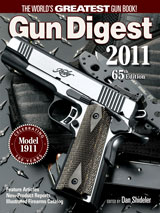 Gun Digest 2011, The World's Greatest Gun Book, 65th Edition
Gun Digest 2011, The World's Greatest Gun Book, 65th Edition
Gun Digest 1944-2009 3-DVD Set
Massad Ayoob's Greatest Handguns of the World
Shop more at gundigeststore.com
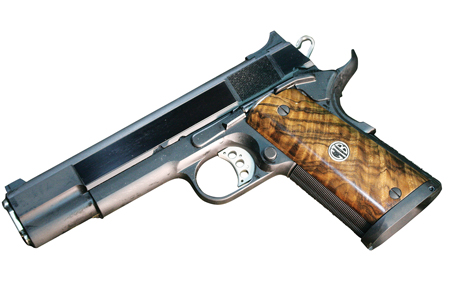 A Tim Brian custom, with the slide edge bevel lighted to show it off. |
Tim and I have this friendly rivalry-complaint going on now for a number of years; Tim is extremely fond of, and is noted for, his Browning Hi-Power treatment of the 1911 slide. Me, I’m not such a fan of it, so when it came time for him to send me a gun to peruse, he made sure that the one he sent was a “BHP slide” gun.
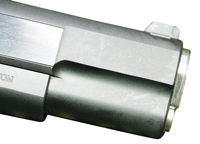 The Hi-Power treatment Tim gives his guns. The more I see, the more I like, but it will still take some time, Tim. |
The best way to describe a CT Brian gun is “radical traditional.” He does a very aggressive de-horning to the bottom of the slide, which results in an almost beveled edge.
That and the frenched borders set off a flat, square, perfectly buffed slide flat, with scalloped edges to the cocking serrations.
On top, a detail of the top flat serrations that might pass unnoticed at the first viewing: he does interrupted line patterns in the serrations. The resulting pattern forms three arrows, pointing towards the muzzle, to help direct your eye to the front sight.
A beveled barrel bushing, with a concentric-crowned barrel, allows all the accuracy the tube (and ammo) is capable of. A huge but not competition-sized magazine funnel and a flat mainspring housing with wide side-grooves complete this pistol.
The matter of mainspring housing patterns is a discussion of long standing between customers and gunsmiths.
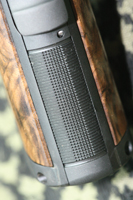 Every surface, every detail, of this Tim Brian mainspring housing has been planned and attended to. |
In the old days, we’d simply cut cross-grooves with a checkering file, using the existing checkering on the mainspring housing and leave the outermost grooves double-wide pyramids.
Now, custom gunsmiths often make their own mainspring housings from scratch (easy enough, with CNC machining stations) and then cut the checkering pattern they want into them. So if you have to have something out of the ordinary, ask.
The grips are smooth, highly-figured, and with an inset CTB medallion. Tim does only full-house custom guns. However, within the full-house build you do have options.
Don’t like the Hi-Power flats? Tim can be talked out of them. Want straight lines, without inset arrows? Again, Tim can be talked out of them. But it seems kind of pointless to go to a guy who does perfect polishing, matte work, borders and grips, and not have him do those things.
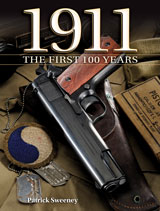 This article is an excerpt from a new book by Patrick Sweeney. Click here to get your copy of 1911: The First 100 Years.
This article is an excerpt from a new book by Patrick Sweeney. Click here to get your copy of 1911: The First 100 Years.
The flag still stands for freedom and they can't take that away!
https://www.msnbc.msn.com/id/40195988?GT1=43001
Leave it to the People's Republik of Californicators to tell a kid he can't display an American Flag on his bike as he rides to school… seems there was some racial tension when some students (are they here legally or are they adding to California's debt by getting free education without paying taxes? ) displayed the Mexican flag on May 5 and others countered by carrying the Stars and Stripes.
Let's make this clear… this is the United States of America… we all came here from somewhere else because it is better here. So the flag that flies here should be our flag… the Stars and Stripes… and no other flag. Yes, I'm fine with you being an African-American, Mexican-American or a German-American. Hell, I am a Polish-American… but in the end.. when all is said and done, you are an American. You came here because our way of life is better. Assimilate and continue to make it better.
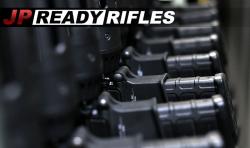 Fans of AR-style guns need no introduction to JP Enterprises, who've built a reputation for premium custom rifles.
Fans of AR-style guns need no introduction to JP Enterprises, who've built a reputation for premium custom rifles.
Now, JP Enterprises is announcing the launch of their new Ready Rifle program of stock JP-15 and CTR-02 configurations ready to ship at a moment's notice. Selected from several of their best-selling builds, each Ready Rifle is identical to a custom one-off JP rifle, but instead of a 4-6 week lead time, these Ready Rifles are built and ready to ship in as little as 2-3 days.
“Long lead times don't make our rifles or any other product prestigious,” said JP president John Paul. “It all comes down to hands-on impact and proven results. We want to get a rifle into the customer's hands now because we're not impressing him one bit for the weeks he's waiting.” By having new rifles available to customers in less than a week, JP expects a rousing response from shooters looking forward to an upcoming match or a hunting trip that's right around the corner.
The program is structured around individual models tailored to the full gamut of uses from duty to competition to hunting to bench shooting. By casting such a wide net, JP aims to win over shooters from every persuasion and already has plans for more configurations to add to the Ready Rifle offerings as the program grows.
For more information on JP Enterprises and their new Ready Rifle program, visit their website at www.jprifles.com
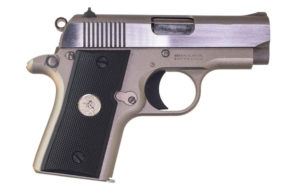
Colt's Manufacturing Company said it will introduce a new and improved version of the classic Colt Mustang. The new Colt .380 Mustang Pocketlite is small, lightweight and boasts enhanced durability, reliability and accuracy, making it an ideal handgun for personal protection.
The precise machining process, use of high quality materials and improvements in design make Colt's new .380 Mustang Pocketlite an excellent choice as a small backup gun.
The aluminum alloy receiver, stainless steel slide and barrel are CNC machined from solid bar stock for precise tolerances. “Machining solid stock is certainly a more involved manufacturing process,” said Joyce Rubino, Vice President of Marketing, Colt's Manufacturing Company, “But it is that process, combined with our engineering specifications, expertise and demand for perfection that allows Colt to deliver one of the highest quality products available to today's marketplace.”
With a loaded magazine, this handgun weighs less than one pound. It measures 5.5 inches long and has a 2.75-inch barrel. The minimal weight and length of the gun, combined with the short single action trigger, grip design, frame design and firing pin safety block, make this firearm ideal for personal protection.
The magazine holds six rounds. Improvements in powder and bullet design have increased the velocity and terminal performance of .380 caliber ammunition, adding to the viability of the Colt .380 Mustang Pocketlite for personal defense.
“Accuracy and reliability was a top priority as we looked at what improvements could be made to make this classic backup even better,” said Rubino, “Though the changes may seem subtle to the untrained eye, every Colt employee takes great pride in knowing that their dedication has helped bring a vastly improved and enhanced firearm to market.”
The new Colt .380 Mustang Pocketlite descends from a famed line of pistols, including Colt's Government Model, and improves upon the best that each had to offer.
For more information on Colt's Manufacturing Company visit www.coltsmfg.com.
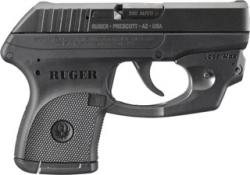 Sturm, Ruger & Company, Inc. has announced new Ruger LCP and LC9 pistols equipped with LaserMax CenterFire lasers. They will come factory fitted with a trigger-guard-mounted LaserMax CenterFire red diode laser.
Sturm, Ruger & Company, Inc. has announced new Ruger LCP and LC9 pistols equipped with LaserMax CenterFire lasers. They will come factory fitted with a trigger-guard-mounted LaserMax CenterFire red diode laser.
“We are very excited about the introduction of the LCP and LC9 with the LaserMax CenterFire lasers,” said Chris Killoy, Ruger Vice President of Sales and Marketing. “Our customers have made these two pistols some of the most popular concealed carry firearms in the nation, and we're happy to provide more options in this product line by incorporating durable LaserMax CenterFire lasers into factory production models. For those who prefer a firearm with a laser, this combination can't be beat,” he concluded.
The new LCP and LC9 pistols both feature a LaserMax CenterFire trigger-guard-mounted laser with ambidextrous on/off switch. The laser can be adjusted for both windage and elevation, and can be removed easily with an Allen wrench (included).
These pistols are polymer-framed, hammer-fired, double-action only. The LCP is chambered in .380 Auto and has a capacity of 6+1 rounds. The LC9, which is available for sale in all 50 states, is chambered in 9mm Luger and has a capacity of 7+1 rounds. Both pistols are designed for snag free carry in a pocket or holster, and come with both flat bottom and finger groove extension magazine buttplates that can be changed to accommodate the shooter's preference.
For more information visit Ruger.com.
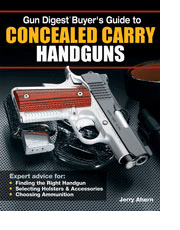 Gun Digest Buyer's Guide to Concealed Carry Pistols
Gun Digest Buyer's Guide to Concealed Carry Pistols
The Gun Digest Book of Concealed Carry
The Gun Digest Book of Combat Handgunnery
Effective Handgun Defense, A Comprehensive Guide to Concealed Carry
Find more resources at gundigeststore.com/tactical
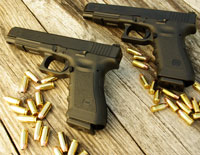 As a press release by Ector noted, “The boycott was initiated by a local Michigan CCW Class Instructor, Rick Ector, in response to that eatery's ban on the possession of all legally carried firearms—openly carried or lawfully concealed carried with a state of Michigan permit. In Michigan, open carry of a pistol in a visible holster is legal without a license. Furthermore, the concealed carry of a handgun is also legal if the person has a Michigan Concealed Pistol License.”
As a press release by Ector noted, “The boycott was initiated by a local Michigan CCW Class Instructor, Rick Ector, in response to that eatery's ban on the possession of all legally carried firearms—openly carried or lawfully concealed carried with a state of Michigan permit. In Michigan, open carry of a pistol in a visible holster is legal without a license. Furthermore, the concealed carry of a handgun is also legal if the person has a Michigan Concealed Pistol License.”
“Ector, a former robbery victim, believes that the restaurant's ban on handguns creates a dangerous dining environment for customers. The reasoning, according to Ector, is that if a business bans guns then armed criminals will know where they can find unarmed people to rob, rape, and assault. The boycott will remain in effect until this local IHOP location drops it gun ban.”
A National Rifle Association credentialed firearms trainer, Ector provides CCW instruction in the Detroit area. Read More
Source: Online PR News 11/13/10
 New! Gun Digest Buyer's Guide to Concealed Carry Pistols
New! Gun Digest Buyer's Guide to Concealed Carry Pistols
The Gun Digest Book of Concealed Carry
The Gun Digest Book of Combat Handgunnery
Effective Handgun Defense, A Comprehensive Guide to Concealed Carry
Find more resources at gundigeststore.com/tactical
The originator of the AR platform has turned its popular M-15 SPR Mod 1 system into what it's calling a “Family of Calibers.”
ArmaLite’s Mod 1 carbine started as a .223/5.56mm carbine built around a one-piece upper receiver/rail system with exclusive detachable side and bottom rails.
This year, ArmaLite is introducing the SPR Mod 1 6.8mm SPC II and the SPR Mod 1 7.62X39mm
ArmaLite’s SPR Mod 1 6.8 is especially well-suited to hunting, according to the company. It is powerful enough to meet the minimum energy requirements of many states for taking medium sized game such as deer.
At the same time, the 6.8mm is lighter than the 7.62×51, reducing the weight of ammunition carried into the field. As part of the AR-platform family, this carbine is also more versatile and ergonomic than traditional hunting models. The Mod 1 6.8mm is built with the ArmaLite-developed mid-length handguard and gas system to provide the best in form and function.
ArmaLite’s SPR Mod 1 7.62X39mm provides all the flexibility of the Mod 1’s one piece upper receiver/rail system but now for the world’s most available cartridge. The original AK-47 was built to use this cartridge.
The ArmaLite designed mid-length handguard and gas tube technology provides an optimal gas pulse to power the 16″ system so reliability is never an issue.
More on the SPR Mod 1 Platform
The SPR Mod 1 is forged, one-piece upper receiver/rail system with exclusive detachable side and bottom rails. The SPR Mod 1's three o'clock, six o'clock, and nine o'clock rails are detachable. That's so you can change your 1913 rails to fit your changing needs for sights, lights, lasers, grips or swivels.
Each SPR Mod 1 comes with extra rails standard, at no extra cost. You get a 1913 rail with quick detachable sling swivel hole. Each rifle comes with a low insert for when you need a bare rail with a low profile. There's also a plain insert with a quick detach sling swivel hole. And there is a half plain, half Picatinny rail as well. Changing your rails and add-ons of the SPR Mod 1 is as easy as turning a torx wrench.
Another good thing: Its one-piece construction offers you a continuous optic platform (COP). There's no gap to bridge between receiver and upper rail when you're installing your scope or sights. This one-piece construction also gives the sighting platform extra rigidity. It's a good, strong backbone. That means your sights will stay zeroed in the most trying conditions. Visit Armalite to Learn More
SPECS FOR THE SPR Mod 1 6.8mm SPC II
Semi-Auto
Caliber: 6.8mm SPC II
Barrel: Free Floated 16″ Double Lapped, Chrome LinedChrome Moly Vanadium MIL-B-11595-E, Threaded 5/8-24
Rifling Twist: RH 1:11″ 110-115 Ammo Grain
Muzzle Device: Flash Suppressor
Front Sight Base: Gas Block with Picatinny Rail Top of gas block is .293 (+/-) lower than top of upper receiver
Upper Receiver: Forged Flattop with Picatinny Rail & Laser Engraved Rail Numbering, 7075-T6 Aluminum w/ 8″ Hand-guard
Lower Receiver: 7075-T6 Aluminum (forged)
Trigger: Tactical Two Stage, 1st Stage 3.5 lbs – 2nd Stage Approximately 5-6 lbs
Overall Length: 36″ with stock extended, Approximately 32.75″ collapsed
Weight: Approximately 7.4 lbs
Finish: Anodized Aluminum Upper/Lower Receiver, Manganese Phosphated Steel Barrel
Accuracy: 1.5 – 2.5 MOA
Included with Rifle: One 10 Round Magazine, Sling, Black Case, Owner's Manual, Limited Lifetime Warranty
SPECS FOR THE SPR Mod 1 7.62X39mm
Semi-Auto
Caliber: 7.62X39mm
Barrel: Free Floated 16″ Double Lapped, Chrome LinedChrome Moly Vanadium MIL-B-11595-E, Threaded 5/8-24
Rifling Twist: RH 1:10″ 123 Ammo Grain
Muzzle Device: Flash Suppressor
Front Sight Base: Gas Block with Picatinny Rail Top of gas block is .293 (+/-) lower than top of upper receiver
Upper Receiver: Forged Flattop with Picatinny Rail & Laser Engraved Rail Numbering, 7075-T6 Aluminum w/ 8″ Hand-guard
Lower Receiver: 7075-T6 Aluminum (forged)
Trigger: Tactical Two Stage, 1st Stage 3.5 lbs – 2nd Stage Approximately 5-6 lbs
Overall Length: 36″ with stock extended, Approximately 32.75″ collapsed
Weight: Approximately 7.4 lbs
Finish: Anodized Aluminum Upper/Lower Receiver, Manganese Phosphated Steel Barrel
Accuracy: 1.5 – 2.5 MOA
Included with Rifle: One 10 Round Magazine, Sling, Black Case, Owner's Manual, Limited Lifetime Warranty